The market is starting to give us a more conclusive view of what’s to come. This month’s report will check in on the widely-expected spring rally and will use the resulting conclusions to forecast where things may go from here.
To start with, some good news: I have partnered up with a fellow who, as a real estate broker, has access to the MLS system. He will thus be able to provide me with key facts and figures that will give us a more up-to-date view of what’s going on. There are some resulting changes to the reported data this month, and you can expect more changes in the months ahead so that we can get as accurate a picture as possible of this quickly evolving housing market.
Let’s get to it.
Prices
The oft-hailed spring rally simply has not shown up to the party.
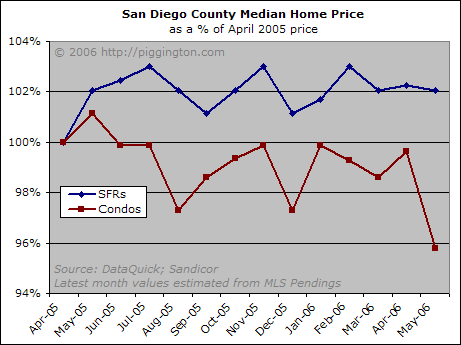
Now, before we go on, let me explain a bit about this data series. Most of the data comes from DataQuick, as it always has; but DQ data is always a month behind compared to MLS. So, the March figure represents DQ data, and April is MLS data that has been normalized to fit in with the DQ data series. There is thus a little bit of guesswork as I am taking the resale-only data from MLS and estimating how it fits in with the resale + new sale data from DQ. That said, I think it probably gives a good view of the directional trends in place—but keep in mind that it is an estimate.
While the April figure is based on MLS sales that closed in April, the May figure is based on sales that went into "pending" in April (i.e., homes that went into escrow). This represents two layers of estimation: the MLS to DataQuick estimation described above, plus the fact that many April pending sales may not end up closing in May, due to cancellations or greater-than-one-month escrow periods. So while I think it is valuable to have a forecast for May sales, please keep in mind that it is very much a rough estimate and take the May figures with a grain of salt.
OK, back to business, what we see in the graph above is that there has been absolutely no upward price pressure this spring. From April 2005 – April 2006, the median SFR price is up a meager 2%, while the condo median is ever so slightly down. That’s correct, the median condo price is now negative year over year.
If the May forecast ends up being even close to the mark, condo prices will be hit even harder next month, while SFR prices will suffer a slight decline. If SFR prices don’t rise next month, the mainstream press’ beloved year-over-year median price will go flat or negative for both condos and SFRs.
For those interested, here’s how this fits in with a longer term trend:
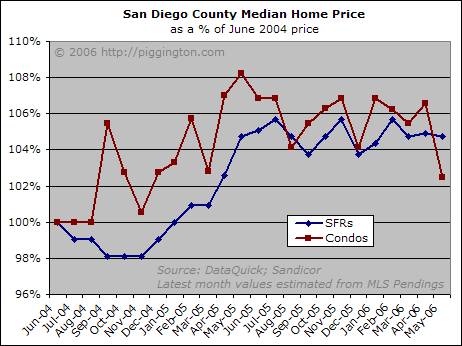
Let’s have a closer look at the idea of a spring rally. It’s been very much the case in recent years that the strongest price gains in the San Diego market took place in the spring and early summer. That’s evident from the chart directly above, but let’s take a closer look at the beginning of last year:
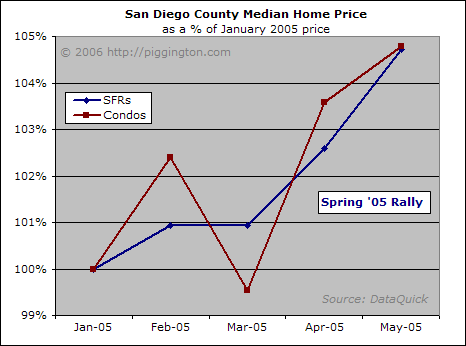
While nowhere near the intensity of the 2004 spring rally, early 2005 saw a nice bounce in home prices, with both the median condo and SFR prices tacking on almost 5%.
Fast forward to the beginning of this year:
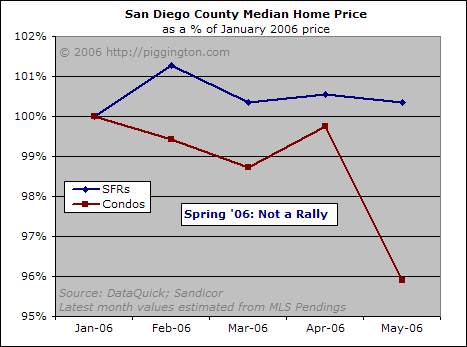
Even if you dismiss the drop in pending condo prices, there is absolutely no sign of a rally or, for that matter, any upward price pressure whatsoever.
The spring rally simply is not happening. This is no big surprise to Premium readers, as I have been postulating that rising inventory combined with the loss of purchasing power resulting from climbing ARM rates would make a rally very difficult. (Here’s a chart of ARM rates to refresh your memory—note the difference between early 2005 and now):
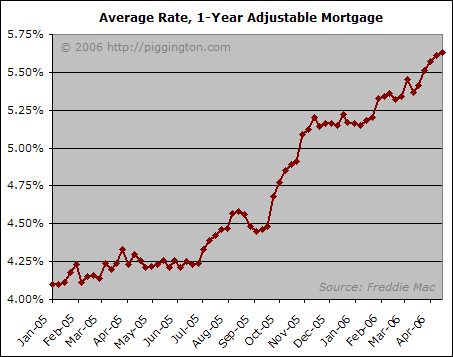
But there is a big difference between me postulating a thing and that thing actually happening. As far as the market data is telling us, the thing is now happening: springtime is here, but prices are going nowhere.
Sales and Inventory
Sales continue to be very weak. I am having some trouble with the DQ sales data, as I think they are misclassifying certain sales and thus (when I filter for what I want) understating how many sales are taking place. I am attempting to work around this issue, but for now, various sources confirm that sales volume is probably down between 30-40% from last year, and we remain mired in a two year declining trend:

Sales were also supposed to pick up during the hoped-for spring rally, but this clearly hasn’t happened to any substantial degree.
The inventory of homes for sale, on the other hand, has continued to grow at a healthy clip:


Slowing sales and rising inventory, or course, means that the "months of supply" figure is growing:
|
Property Type
|
Months of Inventory
|
|
Overall, SD County
|
6.2
|
|
SFR, SD County
|
5.4
|
|
Condo, SD County
|
8.0
|
|
Condo, Downtown SD
|
10.9
|
The figures in the table above are not crisis-level inventory by any stretch (though downtown is a little scary). However, they are high enough to make it difficult for sellers to have any pricing power.
Conclusion
So what happens next?
In the near term, probably nothing. Demand is fairly low and supply is fairly high, so there just isn’t anything putting upward pressure on prices.
But there isn’t a lot of downward pressure either. The tougher interest rate climate hurts a bit in this regard, but this is offset to some degree by the non-traditional loan products that people can use (for now) to lower their initial monthly payments.
If anything, there is a little more downward pressure than upward pressure on prices right now, but overall it seems that we are in stagnation mode and will probably remain there for a while.
At this point, the most likely factor to knock us out of stagnation mode is a rise in the number of people who can no longer make payments. Such despererate sellers change the calculus of the whole picture.
Right now, the vast majority of sellers want to get out, but they don’t need to get out. If they can’t get what they want, they intend to just wait it out. It’s a bit of a stalemate between buyers and sellers. But when a lot more sellers get to the point where they need to sell, things will change. They will have to lower their asking prices to the point where they know they will be able to sell, and if there are enough of them, they will pull pricing market-wide power right down with them.
Loan resets are really the most likely culprit to determine when this will start happening. So allow me some rambling about loan reset timing:
A majority of buyers in the past couple of years have gotten interest-only or negative-amortization loans. Many of these people will be facing substantially higher payments as their loans reset, especially considering that short-term rates are so much higher now than they were in 2003-2005.
However, if someone took out an adjustable loan in 2003 or earlier and their loan resets now, they may be ok because they have some equity in their home (assuming they haven’t already HELOC’d it out).
But appreciation has slowed markedly since the melt-up of early 2004. Anyone who bought after that point may not have a huge equity cushion. So when these people’s loans start resetting, I think that’s when we need to worry. It’s not happening much yet… but, for instance, someone who in late 2004 got a 2/28 ARM (fixed for 2 years, then adjustable for the next 28) will find their mortgage resetting in late 2006. So it may start happening soon. And as time goes on—into 2007 and 2008—it will happen a lot more. This is when things will truly be ugly for housing.
For now, though, the stalemate continues. It can’t continue forever, but it may be several months before things turn down in earnest.
Of course, this is the best guess for right now. Changes in rates, the economy, or the regulatory environment could affect the market more rapidly, but we won’t know about those things unless and until they actually happen. So given the data available to us at the moment, it looks like the most likely course for home prices in the next few months will be flat and perhaps a little down. Later in the year, thought, the stalemate may start to break.
